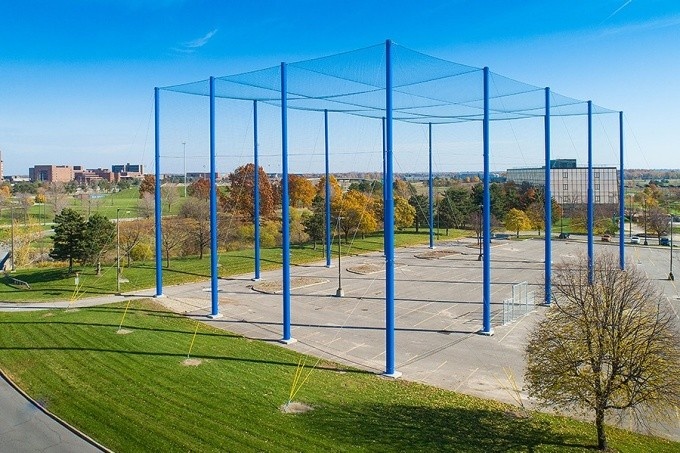Reaching new heights in drone research

Uncrewed aerial vehicle research at UB gets a major boost with a new open-air drone enclosure—among the largest of its kind in the U.S.
The royal blue poles stand upright, like birthday candles on a cake—if birthday candles were 86 feet tall.
They support a massive enclosed netted complex where University at Buffalo faculty, students and partners will conduct experiments on uncrewed aerial vehicles (UAVs), more commonly known as drones.
The 24,000-square-foot research facility is thought to be the third-largest outdoor, enclosed drone-testing facility in the nation. Dubbed SOAR (Structure for Outdoor Autonomy Research), it will help solidify UB’s position at the forefront of research and education in a technology that could improve everything from commerce and national security to emergency response and agriculture.
Pioneering the next generation of autonomous vehicles
The drone enclosure enhances UB’s already significant autonomous vehicle research portfolio, which includes a fleet of cars, an electric bus and a UB-affiliated startup for AI-guided watercraft. In addition to self-driving technology, researchers will use the SOAR facility to study:
- Sensors and surveillance for applications in agriculture, military, homeland security, law enforcement, wildfire monitoring, bridge and building inspections, and more.
- Small parcel delivery and logistics.
- Drone fleets, including the coordination of UAVs as part of disaster response.
The facility will also be a resource for UB students who study robotics and computer vision, and it will benefit Western New York companies interested in using the complex to test UAV hardware.
Ready for takeoff
Because SOAR is enclosed, and thus considered an indoor facility by the Federal Aviation Administration, researchers are not subject to FAA rules when testing UAVs. But the netting still provides realistic flight conditions through all sorts of weather: wind, rain and, yes, snow.
“Our plan is to leave the netting up year-round,” says Chase Murray, assistant professor of industrial and systems engineering. “This will enable us to conduct tests and improve the performance of UAVs in the often-harsh winter weather conditions that we encounter.”
Murray, who studies UAV routing and logistics, among other things, secured a $393,000 grant from the Office of Naval Research’s Defense University Research Instrumentation Program to support the facility’s construction.

